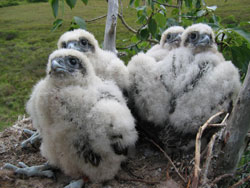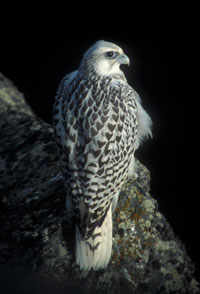Bird Viewing
Alaska's Birders' Birds — Gyrfalcon
- Aleutian Tern
- Arctic Warbler
- Bluethroat
- Bristle-thighed Curlew
- Eastern Yellow Wagtail
- Emperor Goose
- Gray-headed Chickadee
- Gyrfalcon
- Kittlitz's Murrelet
- Long-tailed Jaeger
- McKay's Bunting
- Red Phalarope
- Red-faced Cormorant
- Red-legged Kittiwake
- Rock Ptarmigan
- Spectacled Eider
- Steller's Eider
- Whiskered Auklet
- White Wagtail
- Yellow-billed Loon
Gyrfalcon
 This formidable bird is the largest of all falcons with a wing span stretching as much as four feet across. The gyrfalcon
(Falco rusticolus) has three color phases: black, gray and white, although gray is most common in Alaska. It flies with short rapid wingbeats and does not soar for long periods.
This formidable bird is the largest of all falcons with a wing span stretching as much as four feet across. The gyrfalcon
(Falco rusticolus) has three color phases: black, gray and white, although gray is most common in Alaska. It flies with short rapid wingbeats and does not soar for long periods.
The gyrfalcon is found in open country, tundra, and mountains throughout much of Alaska and nests on rocky ledges. Breeding pairs do not build their own nests and often use a bare cliff ledge or the abandoned nest of other birds, particularly golden eagles and common ravens. The gyrfalcon’s only natural predator is the golden eagle, which rarely engages with the it. Ravens have been known to pick off gyrfalcon eggs and hatchlings.
Gyrfalcons prey on large birds (mostly ptarmigan) and some mammals ranging in size from voles to hares. It is capable of flying at tremendous speeds and usually dives down onto prey on the ground. Most gyrfalcon prey is found with a broken breast bone.
Possible Viewing Areas
-
 Denali National Park – occurs in mountainous sections of the park, either hiking up the Thorofare River or
from the bus at Polychrome Pass, Stony Hill and Eielson.
Denali National Park – occurs in mountainous sections of the park, either hiking up the Thorofare River or
from the bus at Polychrome Pass, Stony Hill and Eielson.
- Creamer’s Field – Fairbanks – in winter
- Steese, Dalton, Richardson, Denali, and Taylor Highways – ocuur on high ridgetops
- Glenn Highway – raptor migration site at milepost 120 (Audubon has yearly hawkwatching field trip)
- Wrangell St Elias National Park - up Jaeger Mesa beyond the end of Nabesna Rd
- Colville River Delta – nesting spot in the foothills near Umiat
- Nome – rocky canyons on first 40-50 miles of Teller Road in late summer and fall; Safety Sound in late summer and early fall;
- Skagway – Klondike Highway near Skagway Summit
Links
- Falcons — Wildlife Notebook Series (PDF 151 kB)
- Google+
